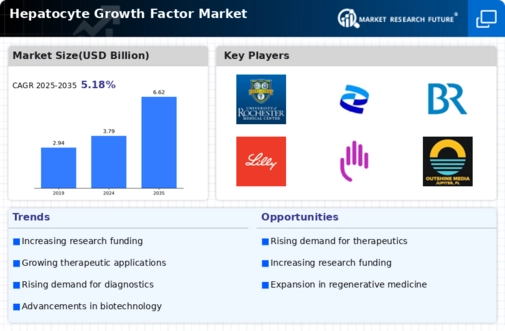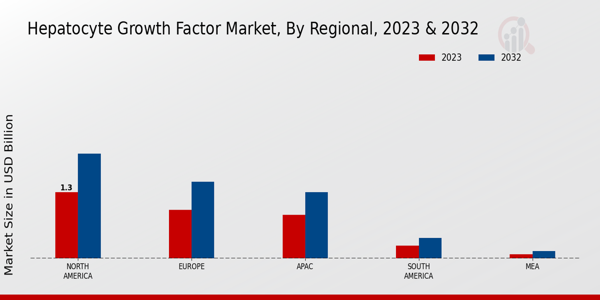Increased Research Funding
The surge in research funding for liver disease therapies is a pivotal driver for the Global Hepatocyte Growth Factor Market Industry. Governments and private organizations are increasingly investing in research initiatives aimed at understanding liver pathophysiology and developing targeted therapies. This influx of funding facilitates clinical trials and accelerates the development of hepatocyte growth factor-based treatments. For instance, national health agencies have allocated substantial budgets for liver disease research, which is likely to enhance the market landscape. As a result, the industry is poised for growth, with a projected market value of 3.79 USD Billion in 2024.
Advancements in Biotechnology
Technological advancements in biotechnology are significantly influencing the Global Hepatocyte Growth Factor Market Industry. Innovations in drug development and delivery systems enhance the efficacy of hepatocyte growth factor therapies. For example, the development of novel biopharmaceuticals and gene therapies has shown promise in treating liver-related ailments. These advancements not only improve patient outcomes but also attract investment in research and development. As a result, the market is anticipated to grow at a CAGR of 5.19% from 2025 to 2035, potentially reaching 6.62 USD Billion by 2035, underscoring the importance of biotechnology in this sector.
Growing Awareness and Education
Heightened awareness and education regarding liver health are contributing to the expansion of the Global Hepatocyte Growth Factor Market Industry. Public health campaigns and educational programs are informing individuals about liver diseases and the importance of early detection and treatment. This increased awareness leads to higher demand for hepatocyte growth factor therapies, as patients seek effective solutions for liver-related issues. Furthermore, healthcare providers are becoming more knowledgeable about the benefits of these therapies, which may enhance patient referrals. Consequently, the market is expected to witness substantial growth, with projections indicating a value of 6.62 USD Billion by 2035.
Rising Prevalence of Liver Diseases
The increasing incidence of liver diseases globally drives the Global Hepatocyte Growth Factor Market Industry. Conditions such as hepatitis, cirrhosis, and liver cancer are becoming more prevalent, necessitating innovative treatment options. For instance, the World Health Organization indicates that liver diseases account for a significant proportion of global mortality. This rising health burden is expected to propel the market, as hepatocyte growth factor plays a crucial role in liver regeneration and repair. As the market evolves, it is projected to reach 3.79 USD Billion in 2024, reflecting the urgent need for effective therapies.
Emerging Markets and Global Expansion
The emergence of new markets and the global expansion of healthcare infrastructure are vital factors driving the Global Hepatocyte Growth Factor Market Industry. Developing regions are experiencing improvements in healthcare access and quality, leading to increased demand for advanced medical treatments. As healthcare systems evolve, there is a growing recognition of the importance of hepatocyte growth factor in liver regeneration and repair. This trend is particularly evident in Asia-Pacific and Latin America, where investments in healthcare are rising. The market is likely to benefit from these developments, with a projected CAGR of 5.19% from 2025 to 2035.
























